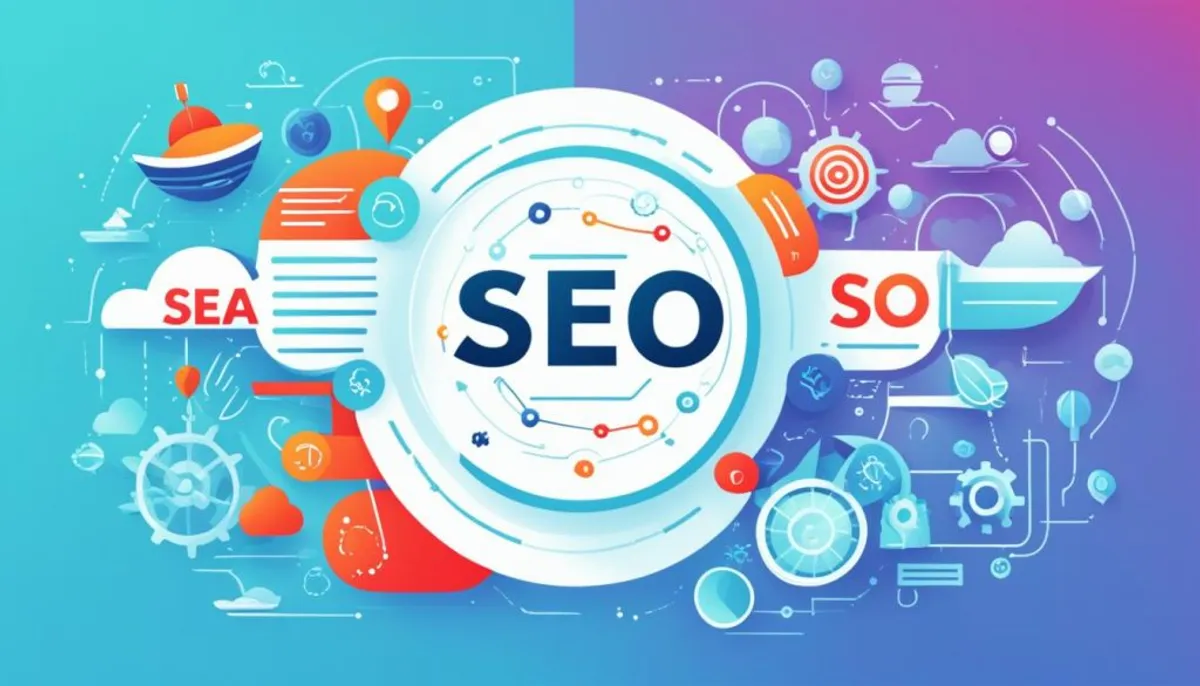Two standout strategies in digital marketing are SEO and SEA. SEO, or search engine optimization, boosts your website’s rankings in search results for free. In contrast, SEA, or search engine advertising, involves placing paid ads in search results. Knowing how SEO and SEA differ is key to smart marketing for your business.

Key Takeaways:
- SEO and SEA are two different strategies for driving traffic to your website.
- SEO focuses on improving organic rankings, while SEA involves paid ads.
- SEO offers sustainability and cost-effectiveness, while SEA provides immediate results and targeting options.
- Combining SEO and SEA can create a comprehensive marketing approach.
- Consider your business goals, budget, and timeline when choosing between SEO and SEA.
Understanding SEO
SEO, or search engine optimization, helps websites get seen more in searches. This means working on your site to do better in search results, mostly on Google.
It’s about boosting a site’s chances to show up first. Making sure your content is really good and what people are looking for helps a lot. If your content is top-notch and meets users’ needs, your site could rank higher.
But it’s not just about the words you use. How your site is built matters too. Things like how fast your site loads, if it’s easy to use on phones, and if search engines can read it well are key. Strong technical aspects can push your site up in search results.
And SEO isn’t only for the computers. It’s for people, too. Your website should be easy and enjoyable to use. Websites that are easy to get around on do better in search and keep people around longer.
SEO is a mix of many things working together. Good content, excellent structure for both people and machines, and a solid technical backbone make the best sites. When everything is working well together, your site can really shine in search results.
By optimizing a website for SEO, businesses can enhance their visibility in organic search results, ultimately increasing their online presence and driving valuable traffic to their website.
SEO Factors:
| Content | Technical Factors | User-Friendliness |
|---|---|---|
| Quality and relevance of content | Site speed | Intuitive navigation |
| Keyword optimization | Mobile optimization | Engaging user interface |
| Meta tags and descriptions | Crawlability and indexing | Clear and concise information |
| Internal and external linking | Structured data markup | Responsive design |
Combining the best of these SEO factors can make your website stand out. It helps draw more attention from search users. And it’s a key part of winning in online marketing.
Understanding SEA
SEA stands for search engine advertising. It’s a powerful way to market your business online. You pay for your ads to show up in search engine results. The main platform for SEA is Google Ads (formerly called AdWords). Here, businesses bid on keywords to show up in searches. This means they can reach people looking for what they offer.
With SEA, businesses get their ads seen right away. These ads show up at the top of search results. Everyone who searches sees them first. This means big visibility and more awareness of your brand.
“SEA provides businesses with instant visibility and the potential for immediate traffic and conversions.”, says Sarah Johnson, a digital marketing expert.
Controlling your ad’s visibility is a big plus of SEA. You get to choose who sees your ads. Businesses can pick certain keywords to aim at a specific group of people. This makes their ads more likely to connect with the right customers.
You also get to manage your budget closely with SEA. You can set limits on how much you spend each day or for the whole campaign. This helps small and large businesses alike. They can make the most of their ad money without overspending.
SEA comes with great tools for tracking how your ads do. Through Google Ads, you can keep an eye on clicks, sales, and more. This info is key. It helps you see what’s working and what’s not. You can then make changes to improve your ad’s success.
Important factors in SEA:
- Keyword selection: Choosing the right keywords is essential for success.
- Ad copy and design: Make sure your ads look good and say something interesting to get people’s attention.
- Budget allocation: Smart budget planning helps you get the most out of your money.
- Ongoing optimization: Regularly checking and improving your ad campaigns is vital for them to do well.
SEA lets you be seen fast, target your ads, manage your budget, and see how your ads are doing. It’s great to use with SEO and other online marketing. Together, they make a strong marketing plan for your business.
Advantages of SEO
SEO helps businesses be more visible online and attract visitors for free. Knowing its perks guides smart digital marketing choices.
Sustainability
SEO keeps drawing in visitors over time, even without ads. This ongoing flow is unlike the quick need for ad money in SEA, offering lasting digital clout.
Cost-Effectiveness
It doesn’t cost to get visits from SEO, making it great for saving money. Building a better website pays off, lifting it in search results without extra pay.
User Relevance
SEO aims to match what users want with what they find online. So, users trust organic search hits more. This trust boosts how users see your site, upping their interest and trust.
Organic Results
Users, studies show, prefer organic to paid search findings. Being in those top results builds your site’s credibility and grabs more clicks, leading to more success.
By using SEO well, businesses enjoy lasting growth, save money, and please users better. But remember, SEO needs consistent work to keep ahead in the online marketing race.
| Advantages of SEO | Description |
|---|---|
| Sustainability | Provides long-term results without ongoing advertising costs. |
| Cost-Effectiveness | More affordable compared to paid advertising. |
| User Relevance | Delivers relevant and highly accessible results to users. |
| Organic Results | Users trust organic search results more than paid advertisements. |
Advantages of SEA
Search Engine Advertising (SEA) is great for businesses that want quick results and to target their ads. With SEA, you can start your ads fast and be seen in search results right away. This quick visibility can increase visits to your site and make your brand more known in little time.
One huge benefit of SEA is reaching exactly who you want. By customizing ads for things like where people are, what language they speak, and their interests, businesses ensure the right eyes see their message. This specific targeting boosts the chance of drawing in customers who are very likely to buy.
SEA also gives full power over ads’ costs. Businesses can decide how much to spend, helping them stick to their budget plans. This control means they can spend their money wisely and get more out of their investment.
Another key perk is being able to measure how well ads are doing. You can keep an eye on things like ROI and how much each click costs. These stats let businesses see how effective their ads are and refine their strategies based on data.
| Advantages of SEA | |
|---|---|
| Immediate results | Ads can be quickly launched, providing instant visibility in search engine results. |
| Targeting options | Ads can be tailored to specific audiences based on location, language, and interests. |
| Control over budget | Advertisers have full control over their spending limits for better financial management. |
| Measurable performance | Metrics like ROI and CPC allow businesses to track and analyze campaign effectiveness. |
Generally, SEA is a key tool for businesses that want quick results and focused ads. By using SEA’s benefits, companies can boost their site visits, make their brand more visible, and enhance marketing for better business results.

Limitations of SEO
SEO has its benefits but also its challenges. It needs a lot of time and effort. You have to update strategies to match changes in algorithms and trends regularly.
It takes a while to see your rankings improve, maybe months or even years. This is because many strive to be at the top, especially in competitive fields. So, you always have to work hard to keep your place.
“SEO is a time-consuming process that requires ongoing optimization and updates to keep up with changing algorithms and industry trends.”
There’s no sure success with SEO efforts. Search engine rules change often, making rankings unpredictable. Something that boosts your visibility today might not work as well tomorrow.
SEO demands that you always adjust and stay informed about the latest trends. This way, you can deal with the surprises that come your way.
Overcoming SEO’s limits needs you to work hard and stay flexible to keep good results.
The Impact of Competition on SEO
SEO faces a big challenge from the sheer number of businesses online. Gaining and keeping high rankings is tough. In very crowded markets, this struggle is even harder. To beat others, companies must really invest in standing out.
The Constant Need for Optimization
SEO is not a one-time thing; it’s ongoing. To be visible and competitive, businesses must always update their strategies. This includes testing and analyzing to follow the latest practices and changes in algorithms.
The Uncertainty of Results
Expecting fixed results from SEO is not realistic. It can give positive outcomes, but their size and form are uncertain. Counting solely on SEO traffic is risky. Diversifying your marketing strategies is key to manage this risk and gain more traffic sources.
| Limitations of SEO | Implications |
|---|---|
| Time-consuming | Requires consistent effort and patience |
| Competition | Fierce competition for top rankings |
| Constant optimization | Continuous refinement and updates needed |
| Uncertainty of results | No guarantee of exact outcomes |
Limitations of SEA
SEA has its perks like quick results and precise ads. But, it comes with some downsides too. For instance, it needs constant money. This is unlike SEO, which can bring in visitors for free.
When businesses use SEA, they rely a lot on Google. Google decides where ads show up and how much they cost. Additionally, the fight for top keywords can make ads very expensive to run.
Running SEA ads well means checking and improving them often. This way, they keep bringing in the results that businesses want.

Choosing the Right Channel
Choosing between SEO and SEA is about your goals, budget, and timeline. Both have their own perks for boosting your marketing.
SEO focuses on lasting success. By enhancing your site, you can rise in search results and grab more visitors over time. It’s perfect for those who want steady growth and commit for the long run.
SEA is for quick wins with the right budget. Paid ads can put you in front of people fast. But remember, keeping up with ads costs money to stay visible and keep those gains going.
The wise choice might be mixing SEO and SEA. This combo suits various goals. It lets you enjoy SEO’s steady growth and SEA’s quick boosts, balancing for better online visibility and success.
Here’s a quick comparison table:
| Factors | SEO | SEA |
|---|---|---|
| Timeline | Long-term strategy | Short-term results |
| Cost | Investment of time and resources | Ongoing budget for ad visibility |
| Goals | Long-term sustainability | Immediate visibility and traffic |
| Benefits | Higher organic rankings, sustainable traffic | Instant visibility, targeted advertising |
Think hard about your aims, what you can spend, and how quickly you need results. Choosing the right mix of SEO and SEA can boost your site’s traffic. It’s key to craft a smart strategy that meets your goals, offering a custom path to digital success.
SEO vs SEA: Complementary Strategies
SEO and SEA work great on their own but even better together. They help you meet both long-term and short-term goals. You will also get more visibility and reach a wider audience by using them together.
Benefits of SEO and SEA Integration
SEO improves your search rankings naturally over time, bringing steady traffic. SEA, on the other hand, uses paid placements for immediate visibility. This mix gives both long-lasting and quick results.
“Integrating SEO and SEA helps meet goals in the short and long term. This improves visibility and reach.”
Long-Term and Short-Term Goals
SEO and SEA come together for a full marketing plan. SEO works for long-term goals, building your website’s presence over time. SEA is perfect for quick wins, like promotions or new product launches.
Increased Visibility and Broader Reach
Blend SEO and SEA for better visibility in both organic and paid search. SEO lifts your organic rankings and search visibility gradually. Meanwhile, SEA targets specific audiences with ads for immediate visibility.
Together, SEO and SEA enhance your online and marketing reach significantly.
Conclusion
SEO and SEA are two ways to get more people to visit your website. They have their own pros and cons. Combining both can be a great marketing move. This mix can fit your business needs well, like your goals and budget.
Keep checking how well your marketing works. This is key to staying ahead online. Using both SEO and SEA helps your site grow. It gets you seen in the long and short term online.
By using both SEO and SEA together, you can do better online. You’ll reach more people and draw more visitors to your site. The right mix of these strategies can really boost your business.
FAQ
What is the difference between SEO and SEA?
SEO focuses on getting a website to show up higher in search results without paying. SEA means buying ads that show up at the top of search results.
How does SEO work?
SEO uses many strategies to boost a site’s rank on search engines. It looks at things like the site’s content, how user-friendly it is, and its technical setup.
How does SEA work?
With SEA, you pick keywords to bid on. You create ads based on these keywords. When someone searches using those terms, your ad can show up at the top of the list.
What are the advantages of SEO?
SEO brings long-lasting results and boosts user trust. It’s also cheaper over time than buying ads.
What are the advantages of SEA?
SEA offers quick results and allows tight control over spending. You can also measure how well your ads are doing.
What are the limitations of SEO?
SEO takes time to see results and needs regular updates. You’re also at the mercy of how search engines change their rules.
What are the limitations of SEA?
With SEA, you’re always paying to stay visible. You’re also in a constant battle with others for the top spot in search results.
How do I choose between SEO and SEA?
Think about your goals, budget, and how quickly you want results. Choose SEO for the long game and SEA for fast, targeted ads.
Can SEO and SEA be used together?
Yes. Using SEO and SEA together can lead to a more effective marketing strategy. This way, you get benefits from both short and long-term goals.
RelatedRelated articles



